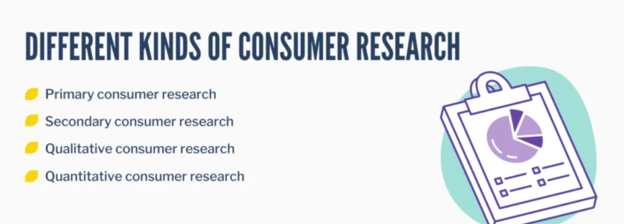
Customers are the heart of any business. And if you’re serious about growing and scaling your business, you must know them in and out. And how do you do this? The answer is consumer research, aka customer research.
In a business, everything revolves around the customer. Without a willing customer, you don’t have a business.
You can spend thousands of dollars on perfecting your product as well as your service.
Or you can offer an ‘N’ number of discounts, but if you’re not targeting the right customers, all your efforts are in vain.
So, how do you approach consumer research?
Just read on!
This article will explain what consumer research is, its different types, its importance, and how it can help your business!
Once you’re done reading this blog, you’ll be able to promote your business in an enhanced way and build customer loyalty efficiently.
What is Consumer Research?
At its heart, consumer research is about understanding your customers’ wants and needs for your business and its products/services.
It’s also about discovering their beliefs and identifying their purchasing patterns, or what motivates them to purchase. The end goal here is to gather and use all the data to serve the customers better.
Consumer research is the key to setting you apart from your competitors.
Think, ‘People. Process. Product.’
‘Listen To People + Build A Process Around The Information = A Better Product.’
A great consumer research example you can consider is that of Verizon in 2003 (then known as Richtel).
Verizon let their customers retain their phone numbers despite them switching cell phone carriers. It became the first wireless company to do so.
What was seen as a disaster that could cost the company thousands of millions of dollars was soon proved wrong. The company generated $3.8 billion in revenue that year (2004).
Related: Consumer Survey: Questions, Methods & Templates.Different Kinds of Consumer Research

Now that you know what consumer research is, let’s dive into the kinds of consumer research methods:
Primary Consumer Research
It is a type of research when you perform the research yourself. To put it another way, you roll up your sleeves and gather the data yourself.
Primary consumer research is cheaper than the other options on this list. Examples include performing direct interviews, mailers, phone surveys, getting responses on social media, and focus groups.
Secondary Consumer Research
Also known as desk research, secondary consumer research is when someone does the research for you and you analyze and act upon this data.
You can buy data from secondary consumer research companies like Gartner, IPSOS, Dynata, Nielsen, IQVIA, and Kantar. Examples of this type of research include online databases, industry reports, and forums or communities.
Primary and secondary consumer research is further divided into two types: qualitative and quantitative.

Qualitative Consumer Research
As the name states, the focus here is on quality. Here, you ask your customers about your products and how they feel about them.
This type of research is descriptive, as it contains open-ended questions that gain valuable insights from the respondents. It is used particularly for asking sensitive questions that people often shy away from answering as compared to yes-or-no questions.
Furthermore, qualitative research is incorporated alongside primary or secondary research. An example of qualitative consumer research would be questions that ask the customers to elaborate on their answers.
Queries like, “What would be your favorite feature about product X?” or “Why did you choose service Y among all the services?”
You’d Also Like: Why Should You Add Open-Ended Questions To Your Questionaire or Surveys? Quantitative Consumer Research
Like qualitative research, you can combine quantitative analysis with primary or secondary research. As the name states, this type of research focuses more on numbers (quantity).
Once you gather the data, you can arrange it or measure it instead of qualitative data, which is objective and inconclusive.
With qualitative research, you can obtain an exact number, such as how much time your customers spend on your website or what percentage of your visitors are male or female.
An example of quantitative research would be questions that have a numerical value as an answer.
Questions like, “Based on your personal experience, how would you rate our product out of 5?” or “On a range of one to five, how likely are you to endorse this product to a family member, friend, or colleague?”
You might also like: How You May Get The Best Results With Survey Data Collection?How Consumer Research Can Benefit Your Business
The importance of consumer research cannot be understated. If you think enough about your consumers, you’ll have all your answers.
Your organization can reap benefits in the ways given below:
You Are On The Same Bandwidth As Your Customers
According to Coveo’s Service Relevance Report 2022, almost a quarter (22 percent) of the customers revealed that they might leave a brand if they received conflicting information from customer service and support agents.
Hence, you must stay up-to-date with the customers’ ever-changing needs.
Generally, your customers will tell you upfront what they might like. For this, all you require is ask the right questions and listen to them.
It is not rocket science, so worry not! You will learn it with a bit of determination and the will to learn.
ALSO READ: Crucial Research Process Steps You Must Be Aware Of! Helps You Gather Crucial Product/Service Feedback
Your customers will tell you about certain improvements they’d like to see. You can then utilize this information to understand their perceptions and appropriately tailor your product/services.
However, customers aren’t always right. Occasionally, they get confused, which is why breakthrough innovations and product repairs are completely different ball games.
You must always use the right piece of information at the right time; you’ll always have newer and better product innovations and improvements.
Forces You To Level Up

You must understand your customers’ unmet needs if you want your product/service to be the best on the market. Assuming what your customers need isn’t a good idea. You must go beyond the general standards to satisfy your customers.
According to a Coschedule study, 56% of the study’s most elite marketers conduct research at least once a month.
The more you research, the more data you have. Moreover, the better and in-depth data you have, the more you can innovate and tend to your customers.
Conclusion
Consumer research is a must, irrespective of your business’s size.
You’ll be a step ahead of your competitors if you deeply understand your audience. Whatever message you hope to convey to your audience or achieve a certain goal, consumer research will make it easier for you.
Ensure you pick the right method, target audiences, ask the right questions, and respect your consumers. You’ll have the answers you need at the end of the day.
As the saying goes, “Numbers don’t lie!”
Ask the right questions, and gather the relevant data. Your business & your clientele will be grateful towards you for it.
So, while we’re on the topic of questions, if you are looking to perform customer research by taking surveys, you must check out SurveyPoint.
The tool allows you to create stunning, loquacious surveys that your audience will like to answer. You can create surveys and build interactive forms, quizzes, and questionnaires.
Interested In Sending Your Own Surveys?
Explore our solutions that help researchers collect accurate insights, boost ROI, and retain respondents using pre-built templates that don’t require coding.




